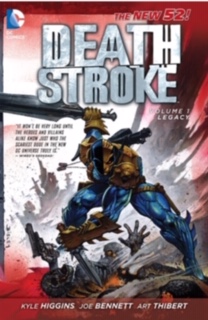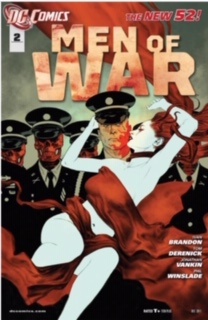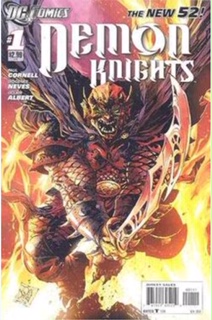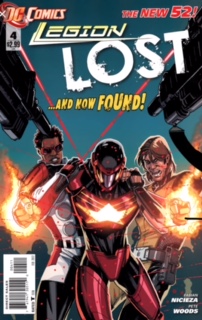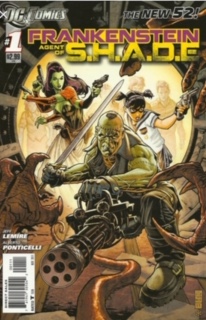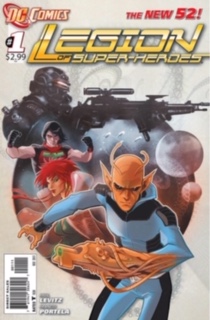Back in 2011, DC Comics took a big chance on the reboot/revamp of their entire line in the publishing initiative known as “The New 52.” While setting the number of titles at a specific number (52) was not an important element, some of the ideas within the initiative were significant. Breaking the line down into different families of books was intriguing and the variety of titles was certainly a whole-hearted attempt at garnering new readers and expanding the scope of the genres. The New 52 has since succumbed to Rebirth, which, at its core, has “fixed” some of the missteps of the 2011 initiative. The most glaring is Superman. While Grant Morrison & Rags Morales and Greg Pak & Aaron Kruder had significant runs on the character, there was always something missing. He became more and more misanthropic throughout. It wasn’t until Convergence when the more familiar pre-Flashpoint Superman reappeared that DC realized it needed to re-incorporate the marriage of Lois and Clark into the Superman mythos, which it eventually did in Rebirth. It appears DC will continue to “fix” even more of those missteps with the eventual proper re-introduction of the Legion of Super-Heroes and Justice Society of America. However, there is something about The New 52 that remains attractive and though at a mere eight years ago, somewhat nostalgic. That said, what can the contemporary DC line learn from The New 52?
Diversity of Genre
In looking back at The New 52, the most significant aspect is DC’s attempt at diversifying their line. While it did homogenize things in a sense, truncating histories to 5 years and taking no chances with proven winners like the Batman and Green Lantern franchises, The New 52 tried to reach a broader audience by separating the books into families and trying out genres that hadn’t been attempted in years.
The families were “Justice League,” “Batman,” “Green Lantern,” “Superman,” “Young Justice,” “The Edge,” and “The Dark.” While “Justice League,” “Batman,” “Green Lantern,” and “Superman,” are fairly
self-explanatory, “The Edge” and “The Dark” really tried to offer something different. Some succeeded and some didn’t, but the very idea is laudable. It’s nothing new to comics to feature different genres of books. Utilizing historical perspective, super-heroes are only the most recent fad in comics, there have been plenty of other types of books that have been successful over the past 85 years of the modern comic book.The two clearest example of success are the “Green Lantern” and “Batman” families of books which altered almost nothing and kept these two franchises chugging along.
The Edge
Looking at “The Edge,” only two titles made it past the two-year mark – Stormwatch and All-Star Western featuring Jonah Hex. While these successes may not have made it past these runs, the Suicide Squad concept, also part of “The Edge,” has graduated into a DC staple, even garnering its own feature film. Additionally, Deathstroke has made it past a short run in The New 52 to a more favourably received series in the Rebirth and post-Rebirth era. But, where is Stormwatch now?
Some of the titles in “The Edge” that deserve a deeper exploration are Blackhawks and Men of War. Both of these concepts leaned heavily to DC’s and Quality Comics’ history of war themed comics. (DC acquired Quality’s line of books in the mid-50s.)
Blackhawks, from the outset, seemed like it didn’t know where it was headed. Despite attractive visuals by Ken Lashley, the concept seemed less than fully developed. Even though The New 52 was looking to re-brand known concepts, a more obvious connection to the history of The Blackhawks would’ve probably helped this concept. Men of War, while re-purposing a short-lived title from the ’70’s was really playing off of classic DC War titles All-American Men of War and Our Army at War. This title attempted to utilize a super-powered descendant of the legendary Sgt. Rock, which seemed to be on the right track, but making him super-powered and connecting him to the other super-powered beings in the mainstream super-heroic DC Universe was clearly in the wrong direction. The closest Men of War got to getting it right were some of the back up stories and the lead story in the last couple of issues by James Robinson which reflected the everyday experience of the American military man in the Middle East. Not only did this echo the classic back up tale of the ’50’s and ’60’s, it was prescient for its time, the United States having sent so many young men to the Middle East in the recent past after the events of 9/11. Classic Sgt. Rock succeeded because it reflected so many truths about war; a super-powered soldier was not right for the concept. However, Sgt. Rock, like the Blackhawk concept, were both on the right track.
The Dark
“The Dark” featured two of the more successful and critically acclaimed series of “The New 52,” Animal Man and Swamp Thing. Both of these titles took the concept of the elemental aspects of nature The Red (Animal Man- meat) and The Green (Swamp Thing- plants.) They crossed over to encounter the Rot, or death and how it affects both elements of nature. There’s no denying that Jeff Lemire and Scott Snyder received well deserved accolades for these titles. For this writer’s money, Swamp Thing was undeniably the best of “The New 52.” More than anything else, a writer with a clear vision is able to make an off-beat concept successful.
Justice League Dark was also included in this family, and it should be no surprise a Justice League title did well. However, the nature of this title was far from standard Justice League fare. This was a solid title that explored the magical and mystical side of the DC Universe with familiar characters, Zatanna, Constantine and Deadman as well as some less recognizable characters.
One of the biggest gambles in “The Dark” family was Frankenstein Agent of S.H.A.D.E. Despite, featuring an un-costumed Ray Palmer who had discovered the shrinking properties of the white dwarf star, it attempted to capitalize on the recent appearance of the monster of Frankenstein in Grant Morrison’s Seven Soldiers of Victory series of mini-series from 2005-2006. For me, this is one of the biggest unrealized opportunities of “The New 52.” The series had a unique concept and always had the character of Frankenstein’s monster at the core. It was this character work that made the series so intriguing. I still want to see Frankenstein’s monster reconcile with his erstwhile bride. His commitment is so strong I would guarantee he is Catholic. Please note that Jeff Lemire who wrote Animal Man was also writing this book. Way to go Jeff!
Demon Knights also bears mentioning. This title added a little sword and sorcery to the line while using familiar characters like Etrigan the Demon and Madame Xanadu. While it utilized some known villains like Vandal Savage, it wasn’t beholden to fitting into a super-hero mold. This was one of the true treats of “The New 52.”
Other Missed Opportunities
During The New 52, there were a few books that could have developed into something bigger. While front loaded, the later period of The New 52 presented some potential for growth upon which DC never capitalized, including Grant Morrison’s The Multiversity and the Phantom Lady and Doll Man mini-series.
Published during The New 52 era, but not under it’s banner, Phantom Lady and Doll Man attempted a new approach to these Golden Age characters. It would be easy to say they were terrible, but they weren’t. The characters were simply under utilized. Perhaps, it was a sales issue. Perhaps it was a lack of coherent direction. No matter, these are classic concepts that have a place in the world of comics. Plus, this mini-series was good.
Perhaps, the greatest of them all was Grant Morrison’s The Multiversity. Though not published under The New 52 banner either, The Multiversity opened the door to a vast number of parallel worlds and concepts. If anything, this should have spring boarded numerous new series that built on Morrison’s foundation or played off the concept. While Convergence seemed to be connected tangentially, no series were developed directly from this event.
The one parallel earth book that did receive some acclaim was Earth 2. It tried to re-imagine DC’s Golden Age characters on a parallel, but without World War II as part of their history. They had a world-wide event of similar impact, but these were young characters, with no history. The series seemed to survive solely on the familiarity of the characters, but the book struggled over time to really find a groove. The most important aspect of those Golden Age characters is their history. That’s part of the appeal, it’s not just a name.
Published in the “Young Justice” family of books, Legion of Super-Heroes and Legion Lost were different explorations of the classic concept of the super-hero club from the far future. Legion of Super-Heroes followed directly from its previous pre-Flashpoint incarnation, albeit with some costume redesigns. Legion Lost focused on a group of Legionnaires that had been displaced in time back to the present day. While the books weren’t bad, the biggest flaws seemed to be the stranding of fan favourites Wildfire and Dawnstar in the present instead of keeping them in the future with the rest of the Legion. Some of the obvious themes of the Legion are diversity and tolerance. More focus on this could have changed the fortune of the Legion in “The New 52.”
What We’ve Learned
There are concepts that will always have appeal. Sometimes they are not executed well. Despite this it is important for DC Comics to try to publish diverse titles. Blackhawk and Sgt. Rock are always worthy of publication. The connection to the past is what matters with these concepts. It’s not always about gender or sexual orientation, sometimes the genre is worth it, but the character work is not there. Kanigher and Kubert did it in their classic Sgt. Rock stories. Men of War flirted with it, albeit it briefly. Lemire and Snyder did it in their New 52 books, Animal Man, Frankenstein Agent of S.H.A.D.E., Batman and Swamp Thing respectively. Both creators focused on character and integrated it into the core series concepts. Some concepts don’t need to be remade.
If it ain’t broke, don’t fix it! Batman and Green Lantern are the most obvious as these franchises have chugged along happily for quite while. And, they have continued to excel in Rebirth.
It’s seems clear that readers are happier with the re-establishment of the status quo for Superman in the Rebirth era. That said, The New 52 Superman is interesting enough to have his own parallel Earth as he grows out of the original Siegel & Shuster concept in an interesting way. (Hey, DC! Parallel Earths are a good thing!) The missed chances with The Multiversity are glaring. Got a new way of looking at a classic concept that is well-loved? Maybe a parallel Earth is the place to try it instead of damaging a popular property.

Keep trying that diversity thing! Suicide Squad finally got going after a couple tries. There’s no reason to think that other concepts won’t make it. The brief run Challengers of the Unknown in The New 52’s DC Comics Presents may not have impressed, but coming out of Dark Knights Metal, there’s another version with an interesting twist on the concept.
The biggest win of The New 52 was the excitement of not knowing what to expect with the new titles. Diversifying the line was and still is a fantastic idea. If the Vertigo imprint can figure out other genres successfully, there’s no reason that the main DC line can’t do it. So, DC, don’t give up on taking chances with different genres. But, commit fully and don’t try to keep a back door open to the super-hero world. You might be surprised.
The DC Comics News Team is behind you all the way!!


